| Article ID | Journal | Published Year | Pages | File Type |
|---|---|---|---|---|
| 8320292 | Current Opinion in Structural Biology | 2010 | 7 Pages |
Abstract
The bacterial cell wall is a complex three-dimensional structure that protects the cell from environmental stress and ensures its shape. The biosynthesis of its main component, the peptidoglycan, involves the coordination of activities of proteins present in the cytoplasm, the membrane, and the periplasm, some of which also interact with the bacterial cytoskeleton. The sheer complexity of the cell wall elongation process, which is the main focus of this review, has created a significant challenge for the study of the macromolecular interactions that regulate peptidoglycan biosynthesis. The availability of new structural and biochemical data on a number of components of peptidoglycan assembly machineries, including a complex between MreB and RodZ as well as structures of penicillin-binding proteins (PBPs) from a number of pathogenic species, now provide novel insight into the underpinnings of an intricate molecular machinery.
Related Topics
Life Sciences
Biochemistry, Genetics and Molecular Biology
Biochemistry
Authors
Pierre-Jean Matteï, David Neves, Andréa Dessen,
